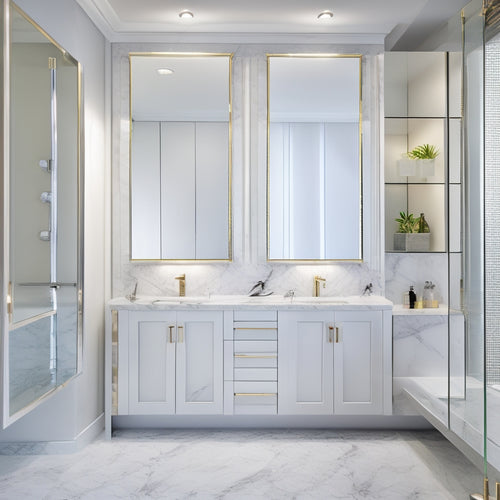
Considerations for Shower Wall Installation
Share
When installing a shower wall, you'll want to evaluate several key factors to guarantee a successful and long-lasting result. First, take precise measurements of your shower dimensions, factoring in finishes like tile or glass that may affect the overall size. Next, choose a material that fits your budget and meets your aesthetic, functional, and maintenance needs, taking into account costs beyond the initial installation. You'll also need to plan for waterproofing and drainage systems to prevent water damage and mold. Additionally, think about design and pattern options, as well as whether to hire a professional or take on the project yourself. Now that you've started, take the next step to exploring these considerations in more detail.
Key Takeaways
- Accurate measurements of shower dimensions and obstructions are crucial to ensure a proper fit and prevent costly mistakes.
- Choose tile materials based on aesthetic, functional, and budgetary needs, considering factors such as cost, maintenance, and replacement costs.
- Install a waterproof membrane and ensure proper drainage with a slight slope towards the drain to prevent water seepage and damage.
- Select tile design and pattern options that reflect bathroom style, lighting, and personal taste, considering color schemes, tile shapes, and sizes.
- Decide between hiring a professional or DIY installation based on comfort level with tiling, weighing factors such as time investment, costs, and potential headaches.
Measuring for Proper Fit
Your shower wall's measurements are essential to a successful installation, as inaccurate calculations can lead to costly mistakes and wasted materials. You don't want to end up with a shower that's too small or too large for your space, do you?
To avoid this, take precise measurements of your shower dimensions, including the length, width, and any obstructions like plumbing fixtures or electrical outlets. Don't forget to account for any wall finishes, such as tile or glass, that may affect the overall size of your shower.
When measuring, use a level and a straightedge to guarantee accurate readings. Record your measurements carefully, and consider creating a sketch or diagram to visualize your shower's layout.
Double-check your calculations to avoid mistakes, and don't hesitate to consult a professional if you're unsure. With precise measurements, you'll be well on your way to a successful shower wall installation that fits your space perfectly.
Material Selection and Budget
Selecting the right materials for your shower wall installation is essential, as it directly impacts the final appearance, durability, and budget of your project. You'll want to evaluate various tile types, each with its own unique characteristics, advantages, and price points.
| Tile Type | Cost Range per Square Foot |
|---|---|
| Ceramic | $3 - $15 |
| Porcelain | $5 - $25 |
| Natural Stone | $10 - $50 |
| Glass | $20 - $100 |
| Mosaic | $15 - $75 |
When conducting a cost analysis, remember to factor in not only the material costs but also the cost of labor, adhesives, and any necessary preparation work, such as waterproofing or surface preparation. It's also important to assess the long-term maintenance and replacement costs of your chosen material. By carefully evaluating these factors, you can make an informed decision that meets your aesthetic, functional, and budgetary needs.
Waterproofing and Drainage Systems
With your tile selection in place, it's time to confirm the underlying structure is waterproof and equipped with a reliable drainage system.
You can't just slap some tiles on the wall and call it a day - not if you want to avoid water damage, mold, and a bunch of other nasty consequences.
You'll need to install a waterproof membrane to guarantee that water doesn't seep behind your tiles. This membrane should be applied to the entire shower area, including the walls and floor.
Don't forget to extend it at least 6 inches beyond the shower's perimeter to create a watertight seal.
Next, you'll need to verify proper drainage. This means creating a slight slope (about 1/4 inch per foot) in your shower floor to direct water towards the drain.
This might seem like a minor detail, but trust us, it's essential. You don't want water pooling in your shower, causing all sorts of problems.
Design and Pattern Options
Now that you've guaranteed your shower area is watertight and equipped with a reliable drainage system, it's time to turn your attention to the aesthetics. This is where the fun begins! You get to decide on the design and pattern options that'll make your shower wall stand out.
When it comes to color schemes, the possibilities are endless. You can opt for a bold, contrasting look or a more subtle, monochromatic approach. Reflect on the style of your bathroom, the lighting, and your personal taste when making your decision.
Don't be afraid to get creative and mix-and-match different colors to create a unique look.
Tile shapes are another vital aspect to think about. From classic squares and rectangles to hexagons and mosaics, the options are vast. You can choose a single shape or combine multiple shapes to create a visually appealing pattern.
Think about the size of your shower wall, the style you're aiming for, and the level of complexity you're comfortable with when selecting your tile shape. By carefully reflecting on these design elements, you'll be well on your way to creating a shower wall that's both functional and stylish.
Professional Vs DIY Installation
You've finalized your design and pattern options, and your shower wall is starting to take shape. Now, it's time to decide who'll bring it to life: a professional or you, the DIY enthusiast. This decision largely depends on your comfort level with tiling, plumbing, and construction.
If you're not familiar with these areas, hiring a pro might be the better choice, despite the added cost. A professional installer will guarantee a flawless, leak-free installation, saving you from potential headaches and costly repairs down the line.
On the other hand, if you're comfortable with the process, a DIY installation can be a cost-effective option. You'll need to invest time in researching, planning, and executing the installation.
Be prepared to spend several weekends on the project, and don't forget to factor in the cost of any necessary tools or equipment. When making your decision, consider the cost comparison: while a pro may charge more upfront, a DIY installation can lead to hidden costs if mistakes are made.
Weigh the time investment against the potential savings, and choose the option that works best for you and your shower wall vision.
Frequently Asked Questions
Can I Install a Shower Wall Over Existing Tile or Other Materials?
You can install a shower wall over existing tile or materials, but don't skip removal options and surface preparation - scrape off old adhesive, clean thoroughly, and guarantee a level surface to avoid a wobbly, water-leaking mess!
How Do I Handle Uneven or Crooked Shower Walls During Installation?
Break out your trusty ol' spirit level, Renaissance expert, 'cause you're about to get medieval on those uneven shower walls! Employ wall leveling techniques and waterproofing solutions to guarantee a straight shot to a leak-free paradise.
What Is the Recommended Thickness for Shower Wall Panels?
You're about to panel up that shower, but what's the magic thickness? Typically, 1/4 inch to 1/2 inch thickness is recommended, depending on panel materials and installation techniques, ensuring a sturdy, leak-free, and stylish space that'll make you sing in the shower!
Are Shower Wall Panels Suitable for Use in Steam Showers?
When you're in a steamy situation, you'll want to know if shower wall panels can take the heat. Fortunately, many panels are designed to withstand steam shower conditions, using materials that resist water and humidity, making panel maintenance a breeze.
Can I Use a Shower Wall Panel as a Decorative Accent Wall?
You're wondering if you can use a shower wall panel as a decorative accent wall? Absolutely! You'll love the design options - from bold colors to textures. Just remember installation tips: guarantee a watertight seal and sturdy backing for a stress-free, stylish result.
Conclusion
As you stand at the threshold of your shower wall installation, remember that the devil is in the details. Measure twice, cut once, and don't skimp on materials or waterproofing. A well-designed shower wall is like a puzzle, with each piece fitting seamlessly together to create a watertight haven. By considering these key factors, you'll be able to step into your new shower with confidence, surrounded by a sleek, functional space that's as beautiful as it is durable.
Related Posts
-

Contemporary Mirrored Bathroom Cabinets for Homeowners
As you reimagine your bathroom, consider a contemporary mirrored cabinet that echoes your unique style, from sleek mo...
-

Mastering Project Management Organization for Success
You know that mastering project management organization is essential for success, but it requires a strategic approac...
-

DIY Hanging Baskets: Stitch, Store, Admire
To craft a DIY hanging basket, precision is key. Begin by cutting four fat quarters of fabric into rectangles and tab...


